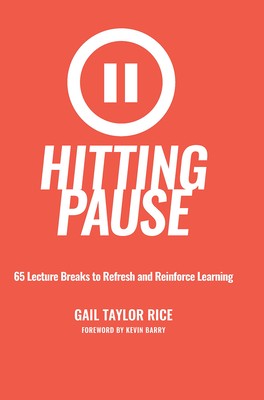
- We will send in 10–14 business days.
- Author: Gail Taylor Rice
- Publisher: Stylus Publishing (VA)
- ISBN-10: 1620366525
- ISBN-13: 9781620366523
- Format: 15.2 x 23.1 x 2.3 cm, hardcover
- Language: English
- SAVE -10% with code: EXTRA
Reviews
Description
Pauses constitute a simple technique for enlivening and enhancing the effectiveness of lectures, or indeed of any form of instruction, whether a presentation or in an experiential setting. This book presents the evidence and rationale for breaking up lectures into shorter segments by using pauses to focus attention, reinforce key points, and review learning. It also provides 65 adaptable pause ideas to use at the opening of class, mid-way through, or as closers.
Starting with brain science research on attention span and cognitive load, Rice bases her book on two fundamental principles: shorter segments of instruction are better than longer ones, and learners who actively participate in instruction learn better than those who don't. Pausing helps teachers apply these principles and create student engagement without requiring major changes in their lesson plans. With careful planning, they can integrate pauses into learning sessions with ease and significantly reinforce student learning. They will also gain feedback on students' comprehension. Rice sets out the characteristics of good pauses, gives advice on how to plan them and how to introduce them to maximum effect. She provides compelling examples and concludes with a repertory of pauses readers can easily modify and apply to any discipline. This book contains a compendium of strategies that any teacher can fruitfully use to reinforce learning, as well as a stepping stone to those seeking to transition to more active learning methods. It: - Makes the case for using pauses- Identifies the primary functions of pauses: focusing, refocusing, enhancing retention, or closing off the learning experience
- Provides research evidence from cognitive science and educational psychology
- Provides practical guidance for creating quick active learning breaks
- Distinguishes between starting, middle, and closing pauses
- Includes descriptions, with suggested applications, of 65 pauses
EXTRA 10 % discount with code: EXTRA
The promotion ends in 19d.13:06:20
The discount code is valid when purchasing from 10 €. Discounts do not stack.
- Author: Gail Taylor Rice
- Publisher: Stylus Publishing (VA)
- ISBN-10: 1620366525
- ISBN-13: 9781620366523
- Format: 15.2 x 23.1 x 2.3 cm, hardcover
- Language: English English
Pauses constitute a simple technique for enlivening and enhancing the effectiveness of lectures, or indeed of any form of instruction, whether a presentation or in an experiential setting. This book presents the evidence and rationale for breaking up lectures into shorter segments by using pauses to focus attention, reinforce key points, and review learning. It also provides 65 adaptable pause ideas to use at the opening of class, mid-way through, or as closers.
Starting with brain science research on attention span and cognitive load, Rice bases her book on two fundamental principles: shorter segments of instruction are better than longer ones, and learners who actively participate in instruction learn better than those who don't. Pausing helps teachers apply these principles and create student engagement without requiring major changes in their lesson plans. With careful planning, they can integrate pauses into learning sessions with ease and significantly reinforce student learning. They will also gain feedback on students' comprehension. Rice sets out the characteristics of good pauses, gives advice on how to plan them and how to introduce them to maximum effect. She provides compelling examples and concludes with a repertory of pauses readers can easily modify and apply to any discipline. This book contains a compendium of strategies that any teacher can fruitfully use to reinforce learning, as well as a stepping stone to those seeking to transition to more active learning methods. It: - Makes the case for using pauses- Identifies the primary functions of pauses: focusing, refocusing, enhancing retention, or closing off the learning experience
- Provides research evidence from cognitive science and educational psychology
- Provides practical guidance for creating quick active learning breaks
- Distinguishes between starting, middle, and closing pauses
- Includes descriptions, with suggested applications, of 65 pauses


Reviews